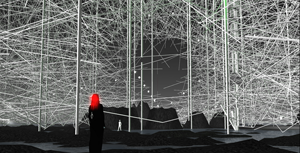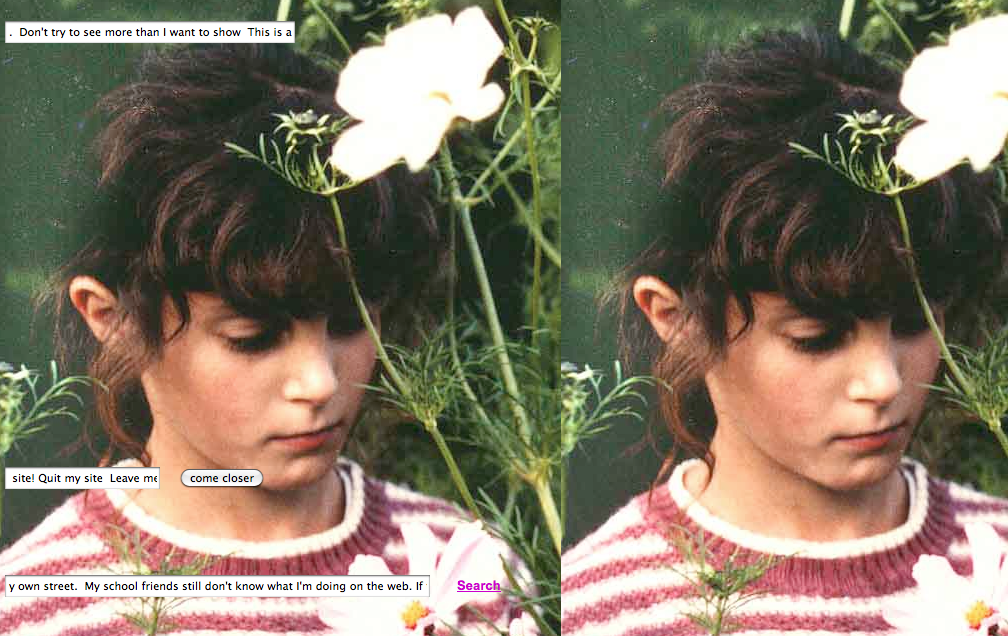Lisa Cianci
Courses: Diploma of Graphic Design (CUV50311), Diploma of Visual Art (CUV50111)
VUIT Digital Arts
Teacher Name: Lisa Cianci – email: lisa.cianci@vu.edu.au
Education Manager: Adam Hutterer – email: adam.hutterer@vu.edu.au
Class Website – http://multimedia.tafe.vu.edu.au/lisa/2015/CSV
Class 14 – Lecture Notes
This document URL: http://multimedia.tafe.vu.edu.au/lisa/2015/CSV/class14/2015_CSV_class14.html
Lecture Notes – New Media in Art & Design: using video, objects, performance, interaction and participation
New Media Art came out of a range of contemporary art and design movements such as conceptual art, performance art, Fluxus, video art, computer art etc.
One might define New Media Art as art that uses all or any of the three following elements:
interactivity (artists/users/audience/participants engaging actively with the work)
connectivity (use of networks such as the Internet to distribute the work & create connections between artists and audience)
computability (computational and based on algorithms)
Many people understand new media art to involve digital technologies and emerging technologies in conjunction with social/political/cultural implications. Conceptual Art & Fluxus have been a major influence in new media art because of the use of intermedia, and the importance of interaction/participation and the breakdown of the artist/author as privileged over the audience/reader/participant.
Because of the use of the Internet as a site for location, proliferation, communication and presentation of a lot of new media art, it is considered to be a worldwide movement without geospatial barriers, although issues such as censorship and ownership of the Internet are important factors that prevent complete freedom of expression online for many artists. Some new media artists work with concepts of ownership and censorship in the same way that Fluxus artists fought against certain socio/political issues from the early days of Fluxus.
This online wiki version of the book “New Media Art” by Mark Tribe is an excellent brief history of new media with a list of significant artists that are considered to be proponents of new media art.
https://wiki.brown.edu/confluence/display/MarkTribe/New+Media+Art#NewMediaArt-DefiningNewMediaart
This article on Rhizome.org is also a great place to start.
http://rhizome.org/editorial/2012/dec/6/whats-really-specific-about-new-media-art-curating/
Rhizome.org is an organisation that was established in the late 1990s in New York and has become a portal or hub for new media arts and for artists to communicate and participate in an online space. They also host an archive of new media artworks that is unique and valuable as these types of works are ephemeral and “variable” by nature and very hard to preserve given the software/hardware/network technologies that are required to support them.
Here are just a few significant artists that may be considered “New Media Artists”. Their work is diverse and covers many forms and styles, but you should consider whether each of these artists fits with the three elements defined above…
Stelarc (Australia)
performance art using robotic prostheses <http://stelarc.org/>

Stelarc, Multiple Hand 1998
Cory Arcangel (USA)
Super Mario Clouds – hacked gameboy catridges
Mary Flanagan (USA)

Mary Flanagan, Phage, 2000 (mod of the Unreal Tournament game engine)
Francesca Da Rimini (& VNS Matrix) (Australia)
“Dollspace”, dollyoko.thing.net <http://dollyoko.thing.net>


Francesca Da Rimini, Dollspace, 1997 (HTML interactive website)
Olia Lialina (Russia/USA)
My boyfriend came back from the war <http://myboyfriendcamebackfromth.ewar.ru/>

Olia Lialina, My Boyfriend Came Back from the War, original HTML interactive website, 1996
Lev Manovich (Russia/USA)
software studies initiative <http://lab.softwarestudies.com/2011/06/mondrian-vs-rothko-footprints-and.html>

Lev Manovich, Mondrian+Rothko.X_brightnessMean.Y_saturationMean.images, 2011 (“Big Data” software analysis of artworks)
Melinda Rackham (Australia)
Empyre <http://www.subtle.net/empyre/>
Empyrean (3D space) <http://www.subtle.net/empyrean/>

Bill Viola (USA)

Bill Viola, Emergence, 2002 Video & Installation
Mark Tribe (USA)

Mark Tribe, Dystopia Files feat. Frédéric D. Oberland at Cinéma des Cinéastes, Paris, 2010, Video
Selavy Oh (Second Life)
(the name of this artist’s avatar is a play on Duchamp’s female alter-ego Rrose Sélavy)


These images capture from Second Life performance by Selavy Oh, images stored on Selavy Oh’s Flickr Photostream
Oh, Selavy 2009, “Erasing the Spiral”, <http://www.flickr.com/photos/selavyoh/4081134136/in/photostream/>
Oh, Selavy 2011, “Into the Past”, <http://www.flickr.com/photos/selavyoh/5772750789/in/photostream>
Oh Selavy 2012, “The Next Day”, <http://www.flickr.com/photos/selavyoh/6955297103/in/photostream/>
Oculart (Geoff Lillemon) (Netherlands)
http://www.geoffreylillemon.com/website/

Oculart 2006, Flash animation

Oculart 2006, Flash animation
Martine Neddam (Netherlands)
Mouchette <http://mouchette.org>

Martine Neddam, Mouchette (HTML interactive artwork), 1996
Eduardo Navas (USA)
Remix Theory <http://remixtheory.net>
<http://remixtheory.net/remixImages/lotusAnalaytics/LotusOrig_YZ.jpg>

Eduardo Navas, Radiohead Lotus Flower remix, 2011 (software analysis of youtube remixes of Radiohead Lotus Flower video)
Mark Amerika (USA)
Remix the Book <http://www.remixthebook.com/>

Mark Amerika, Remix the Book, website, publication and remix project
Glitch Art (a sub-genre of new media art)
http://www.furtherfield.org/features/articles/glitch-symbolic-form
Rosa Menkman (glitch artist) (Netherlands)
http://rosa-menkman.blogspot.com.au/

Rosa Menkman, Collapse of PAL, image from an A/V performance, 2010
===========================================================
Questions to consider:
- Who are some of the artists mentioned today that might be called “new media artists”?
- What are the specific elements of an artwork that could be considered “new media”?
- Find two or three new media artists that interest you and explore further

